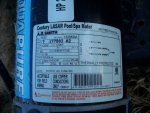I'm needing to get our pool pump wired up properly as I've had enough of us running it the no-no way (yep, we've been using a drop cord). We were going to have it done by a proper electrician but the guy turned out to be a thief and disappeared with some of our money and no work was done. But that is a different issue altogether.
In any case, I'm going to do the majority of the work myself. I'll dig the trench, lay the wire and hook up the outdoor recepticle for the plug from the pump. This way I can unplug the pump and take it indoors when we close the pool down for the winter. Then I'll have a qualified electrician (different person naturally) connect the underground wire to the main house electrical panel (which is on the outside of the house).
What I need guidance with, is what type of wire do I ask for that will safely run the pump when I go to purchase it. The type I'm after is the one that can can buried in the ground that doesn't need to be in any type of PVC conduit - I hope that made sense - as I'm trying to keep the costs down so that I don't have to resort to the no-no way again. I don't know the name of that wire and I also don't know what guage (?) I should get, since I am no electrician. Oh, I'd also like to know what size fuse I would need to buy that goes in the main panel.
Below is a picture of the pool pumps specifications which is a 2.5 HP. The distance from the recepticle to the main panel is 130 feet. As always, thanks in advance.
In any case, I'm going to do the majority of the work myself. I'll dig the trench, lay the wire and hook up the outdoor recepticle for the plug from the pump. This way I can unplug the pump and take it indoors when we close the pool down for the winter. Then I'll have a qualified electrician (different person naturally) connect the underground wire to the main house electrical panel (which is on the outside of the house).
What I need guidance with, is what type of wire do I ask for that will safely run the pump when I go to purchase it. The type I'm after is the one that can can buried in the ground that doesn't need to be in any type of PVC conduit - I hope that made sense - as I'm trying to keep the costs down so that I don't have to resort to the no-no way again. I don't know the name of that wire and I also don't know what guage (?) I should get, since I am no electrician. Oh, I'd also like to know what size fuse I would need to buy that goes in the main panel.
Below is a picture of the pool pumps specifications which is a 2.5 HP. The distance from the recepticle to the main panel is 130 feet. As always, thanks in advance.





 You'd really be better off doing that, but I understand finances.
You'd really be better off doing that, but I understand finances.
